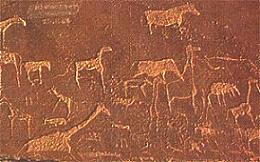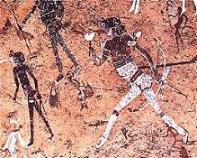Rock art in Namibia
Information on location, meaning and protection of rock
art.
Pictures, drawings, designs or images painted or
engraved on the rock surfaces are generally referred to as "rock art". The
paintings are usually found on a walls of rock shelters (caves, etc.) formed in cliffs
in the mountains of the country. The engravings are also found on the large boulders and open surfaces of
rocks laying on hillsides, particularly at Twyfelfontein area.
The images and ideas that were used by the ancient artists always differ from
site to site and country to country. An analysis of more than 15 000 rock engravings in Namibia has
confirmed that
animals, their spoors and abstract motives of images are represented almost equally. The ratio is 31, 30 and 32 percent respectively. On the contrary a
human figures are used in only 3 percent of engravings.
The ratio is 31, 30 and 32 percent respectively. On the contrary a
human figures are used in only 3 percent of engravings.
Who were those artists and engravers? Who made the rock art? In Southern Africa and particularly
in Namibia the artists were mainly San (Bushmen) hunters. The age of rock engravings
is believed to range from 2 000 to 6 000 years old while some painted images have been
dated up to 25 000 years old.
One of the most f amous rock engravings site in Namibia is Twyfelfontein
("Doubtful Fountain", see
photo album) in Damaraland where more than 2 500 images have been
recorded and catalogued as well as several paintings. The engravings and
images were first recorded in 1921 by Mr. R. Maack in the report written for the SWA Administration but the first detailed study of the
site was conducted by Mr. Albert Viereck. The name Twyfelfontein was given to
the place by Mr. David Levin, a
sheep farmer, who moved to the area in 1947 and had to rely on unreliable water
spring. There is a shelter where paintings of human figures
can be seen. Most interesting is the fact that both forms of rock art (engravings and
paintings) can be found in Namibia unlike South Africa where they are mostly
geographically separated with an exception of Northern Cape. There is an opinion that older
hunters used the engravings to teach their children about the animals and the
strange circular images found at Twyfelfontein were used as a maps to indicate water sources in
the area.
amous rock engravings site in Namibia is Twyfelfontein
("Doubtful Fountain", see
photo album) in Damaraland where more than 2 500 images have been
recorded and catalogued as well as several paintings. The engravings and
images were first recorded in 1921 by Mr. R. Maack in the report written for the SWA Administration but the first detailed study of the
site was conducted by Mr. Albert Viereck. The name Twyfelfontein was given to
the place by Mr. David Levin, a
sheep farmer, who moved to the area in 1947 and had to rely on unreliable water
spring. There is a shelter where paintings of human figures
can be seen. Most interesting is the fact that both forms of rock art (engravings and
paintings) can be found in Namibia unlike South Africa where they are mostly
geographically separated with an exception of Northern Cape. There is an opinion that older
hunters used the engravings to teach their children about the animals and the
strange circular images found at Twyfelfontein were used as a maps to indicate water sources in
the area.
Twyfelfontein was proclaimed a national monument in 1952.
There is no certainty on the reasons why the rock art was made. Some experts
believe that it were the pictured reminders of some events or records of history
of the particular tribe/area. Another purpose could be a
representation of religious beliefs, ceremonies and/or a trance experiences. It could
also be a way of communication between tribes.
How long will rock art be with us? No doubt that the exposure to the elements is causing
a damage constantly. An engravings become eroded and paintings fade with passage
of time. But the major threat to the rock
art are humans. The best way of protection of the rock art is by not touching it
or tempering with it at all.
It is highly damaging to spray any liquid on the paintings and engravings.
Rock art etiquette
Rock art is extremely sensitive to humans, and is often damaged by attempts to
touch it or to make the rock art stand out on photos. Even walking too close to
the art can cause damage. Most rock art is extremely old, and has survived for
thousands of years because there hasn't been any damaging impact from humans.
Use these guidelines to make sure that the rock art is still visible and in good
condition for your next visit, and for generations to come.
DO enjoy the rock art, but DO NOT add your own or paint on the rock art.
Creating modern "rock art" is known as vandalism.
DO NOT use any powders, chemicals or liquids, to increase visibility. Not even
distilled water! Not only do these destroy the rock art, but can make dating and
further research impossible.
CAMPING NEAR ROCK ART SITES
DO make use of provided campsites and DO NOT "pioneer" new campsites.
DO NOT make any camp fire within a 2 km radius from a rock art site. Smoke
causes damage.
DO enjoy a African evening around the camp f ire, however.
WALKING IN THE VICINITY OF & VIEWING OF ROCK ART
DO take your time to view and appreciate the rock art and landscape and DO bring
binoculars or telephoto lenses for a better view or picture.
DO have a walk around the site and if walkways have been provided for your
convenience DO use them.
DO NOT try to get a better view or picture by standing or walking on or close to
rocks that show even the faintest indications. that they may have rock art on
them. The vibrations from footsteps can loosen pigments and can destroy it.
NEVER, EVER touch any rock art, even rock engravings, as natural body oils
shorten their life spans, and porous rocks may flake off.
PHOTOGRAPHING ROCK ART
DO take photographs.
Photos of rock art do not work well if there is an extreme contrast between
light and darker areas or glaring sun, so for the best photo's:
* plan your trip for early morning or late afternoon, when the sun is not
glaring.
* choose a time of day when the sun is shining at an angle across the rock.
* use a polarizing filter in bright sun, and
* if all else fails do enhance your digital photos later with Photoshop or other
computer programs.
SKETCHES & DRAWINGS
DO make sketches & drawings. You will notice much that you otherwise might have
missed.
DO NOT do “rubbings”, “traces”, “chalk the rock art” or in any way make contact
with the rock art or surrounding surface. The surface of rocks may be weakened
and later fall off.
GENERAL
DO pick up trash left by others, but DO NOT add litter to the site.
DO take a look at the plants and animals at the site, but DO NOT remove or
disturb them. Not even lichens or moss, they are an important part of any rock
art site.
DO enjoy what you are seeing, and leave with only photographs, memories, and
whatever you brought in with you. Leave everything else in place for the next
person to see and enjoy.
What has sometimes survived for a thousand years can be lost in a minutes simply
because someone did not think about the consequences of their actions,
STOP, LOOK and THINK before acting.
Pictures:
Giraffe
Dancers (painting)
Elephant
Wildebeest
Lion
Related:
Twyfelfontein, Twyfelfontein
Lodge, Attractions of Damaraland,
Paula's Cave, Mowani
Camp, Huab Lodge, Xaragu Camp,
Bushman's Paradise Cave,
Brandberg
Bradshaw Foundation
Contact:
E-mail:
info@namibweb.com



Page created and serviced by

www.namibweb.com
Copyright © 1998-2025
namibweb.com - The online guide
to Namibia
All rights reserved |
JOIN
|
VIDEO PORTFOLIO
|
VIDEO/PHOTO COLLECTION
Telegram
| YouTube |
Blog
Page is sponsored by ETS &
Exploring Namibia TV
Disclaimer: no matter how often this page is updated and its accuracy is checked,
www.namibweb.com and ETS
will not be held
responsible for any change in opinion, information, facilities, services,
conditions, etc. offered by
establishment/operator/service/information provider or any third party
